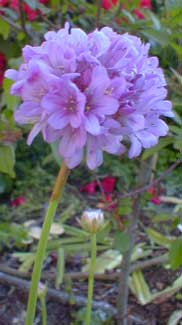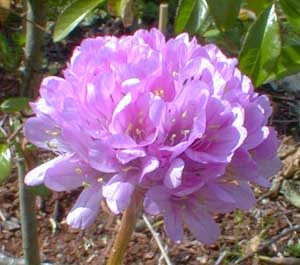
Formosa Pinkball Thrift,
Giant Sea-thrift, Giant Seapink,
Estoril Thrift, or
Plantain Thrift
"To all souls the hidden beauty calls,
The sea thrift dwelling on her spray-swept height,"
-Eva Gore-Booth
(1872-1946)
(1872-1946)
Armeria pseudarmeria is commonly mispelled pseudoarmeria; & because so many catalogs have copied a misspelling on a widely distributed seed package, sometimes both genus & species are misspelled Arneria pseudoarmeria.
 It was formerly called A. cephalotes or A. latifolia & still often listed under the outdated names. In addition, the large-flowering clones of the 'Formosa' & the 'Joystick' series are sometimes listed as though the species name were A. formosa. To add to the confusion, some of these plants even from the wild are naturally hybridized with A. welwitschii.
It was formerly called A. cephalotes or A. latifolia & still often listed under the outdated names. In addition, the large-flowering clones of the 'Formosa' & the 'Joystick' series are sometimes listed as though the species name were A. formosa. To add to the confusion, some of these plants even from the wild are naturally hybridized with A. welwitschii.Thrifts are also called Sea-thrifts or Sea Pinks, because they are maritime climate flowers unhampered by salt when growing near the ocean. The Pinkball Thrift or Giant Sea-thrift is native to coastal Portugal. It could be the twin of the common thrift except that it is a dozen times bigger. Instead of the little groundcover turf with eency thrift-flowers rising a half-foot high, there are sixteen-inch stems rising from the strappy evergreen basal turf, with two-inch golfball-sized pink & rose-pink flowers.
'Formosa' thrifts erennialize well in well-draining soil in full sun, but can rot out of the garden if it remains too wet. It's a good choice for the xeriscape garden, needing very little water.
Superb for rockeries, garden edges, mixed borders, cutting gardens. It is in fat bud by April with mild flowering for late spring, intense flowering starting May & lasting all summer long. With deadheading flowers can persist through much of autumn; without deadheading a clump will go to seed then stop blooming after six or eight weeks. T